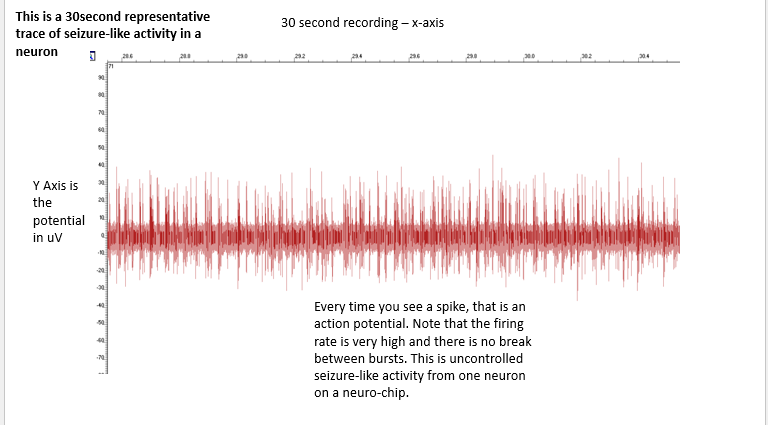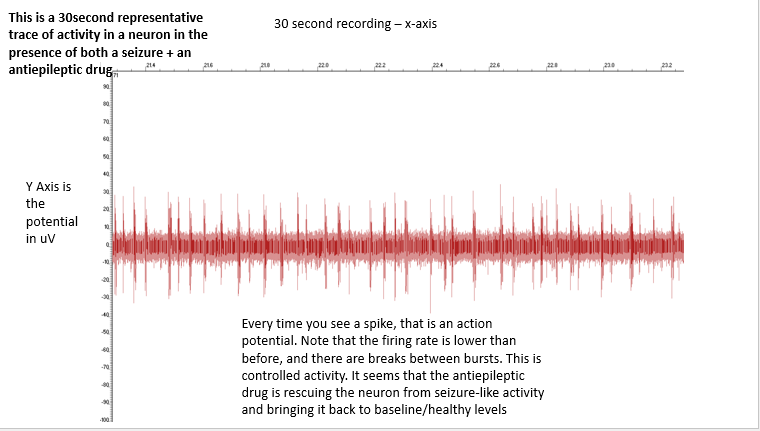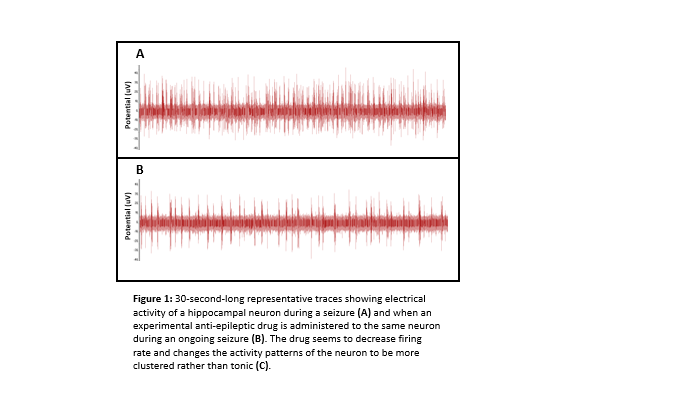Epilepsy and Advanced Research Techniques
Grade 7
Presentation
No video provided
Problem
Epilepsy and Advanced Research Techniques
Problem
Epilepsy is a chronic neurological disorder that affects over 50 million people around the world regardless of their gender or ethnicity. Unfortunately, despite the detrimental effects of epilepsy, there is still no cure.
Treatment
While there are several treatment options ranging from anti-epileptic medications, to invasive brain surgery, ketogenic diets, and now even nerve stimulation devices that counteract seizures; these options are not without their own side-effects, such as drug-induced toxicity and cognitive decline, to long-term desensitization to stimulation devices. Because of this, there is a need to develop safer and more effective medications that serve as many patients as possible. Unfortunately, the drug discovery process is long and tedious, and cannot easily be scaled up to clinical use. One tool that can help bridge this gap is neuron-chip interfaces such as neurochips for rapid drug screening. My project looks at these advanced treatment approaches, with a particular focus on the use and validation of novel neurochips to study the effectiveness of new anti-epileptic medications on seizure prevention and seizure recovery on rat neurons.
Method
Method:
1.My Google Search
Search terms:
-
-
- “What is Epilepsy”
- “Causes for Epilepsy”
- “Epilepsy Treatment Options”
- “Advanced Treatments”
-
I started with a web search, using Google.ca to input queries. The search terms were “What is Epilepsy”, “(Date: December 23, 2023)” , From empoweringepilepsy.org.
Symptoms of Epilepsy” (Date: December 24, 2023)” From .mayoclinic.org/diseases-conditions/seizure/symptoms-causes.
“Common Causes of Epilepsy” (Date: December 26, 2023)”, From mayoclinic.org/diseases
“Diagnosis of Epilepsy” (Date: December 27 2023):, Website: mayoclinic.org/diseases
“Types of Epilepsy” (Date: December 28, 2023): , Website: ninds.nih.gov/health
“Treatments” (Date completed this part Dec 25, 2023, January 4, 2024):, Website: cureepilepsy.org/
I only used websites that were managed by government or medical bodies or had verified references in their articles.
Sought Expert Advice about how drug discovery and screening works.
I Contacted researchers at the University of Calgary’s Cumming School of Medicine. These conversations contextualized my understanding of epilepsy. Expcontactedosed you to novel technologies in drug discovery and screening.
Micro-electrode arrays and other neuron-electrode/neuron-chip interfaces.I Gained hands-on insight into how these chips can be used to screen AEDs. Shadowed scientists as they tested novel drugs for their effectiveness in preventing or stopping seizures in neuronal cultures.
Research
Epilepsy and Advanced Research Techniques
My Motivation!
What motivated me to choose this topic?
One of my friends had a severe seizure attack while we were writing the PAT exam. Students were very scared to see that situation, and everyone left the room except the teacher. I had never seen this situation before. However, that critical condition made me interested in knowing about these Seizure attacks of Epilepsy, Advanced Research and Treatment Options at the present time.
Introduction:
Epilepsy is a chronic Brain-Based Disease, which is also called Seizure Disorder. Biologically, actually, it is caused by a Chemical Imbalance in the Excitation and Inhibitory activity in the Brain, and this can cause Brain Damage or Death. Epilepsy is a non-communicable disease, in other words, it’s not spreadable. It is not like Viral disease. Did you know that Epilepsy is one of the most common diseases in the world, also Epilepsy can affect people of all ages regardless of their gender or ethnicity, in addition, 80% of people who have epilepsy are from low and middle-income countries, but Approximately 50 million people all over the World live with Epilepsy but 70% of people can live without seizures if they are properly diagnosed and treated.
Difference between Epilepsy and Seizure Attacks:
Epilepsy: Epilepsy is a chronic Brain-based Disease, which is non-communicable (Non-Spreadable). It is not like Viral disease.
Seizure Attacks: A seizure is an Event.
It is the Primary Symptom of Epilepsy. The Brain works by sending Electrical Signals through Nerve Cells. Changes or Interruptions in Electrical Signals can cause a seizure.
Seizure Attacks
When there are Abnormal Changes in Electrical Activity and Nerve Cells don’t communicate with each other, this may cause a Seizure attack. A seizure is an Event. It is the Primary Symptom of Epilepsy. Did you know that the Brain works by sending Electrical Signals through Nerve Cells, but when there are changes or Interruptions in the brain's Electrical Signals this could cause a seizure attack?
Symptoms of Epilepsy
There are several symptoms of Epilepsy which could range from Mild to Severe. The Most Common Symptoms of epilepsy are the following:
- Temporary Confusion.
- A Staring Spell.
- Jerking Movements of the Arms and Legs that can't be controlled.
- Loss of Consciousness or Awareness.
- Cognitive (Thoughts) or Emotional (Feelings) Changes.
Seizure Triggers
Seizures and Epilepsy can affect Safety, Relationships, Work and Driving. Stress (External Pressure in the Brain) could be Exam Stress, Study Stress Financial Stress etc. Excessive Drinking of Alcohol, or Alcohol withdrawal, Hormonal Changes in the body can stimulate Seizures. Lack of Sleep is also a factor in seizures, and Visual Stimulation such as Flashing Lights or Moving Patterns can stimulate seizures.
Causes of Epilepsy
There can be many causes of Epilepsy.
- Genetics: If Epilepsy is in the Family, there is a higher risk it can happen to the other family members.
- Brain Tumors: It is a Cancerous mass which is due to the growth of abnormal cells in the brain that can cause Epilepsy.
- Head Trauma: Head Injury can also cause Epilepsy.
- Alcoholism & Withdrawal: Use of alcohol and bio-changes after stopping alcohol can cause Epilepsy.
- Alzheimer's Disease: This may cause Epilepsy.
- Strokes, Heart Attacks, and other conditions:
- Loss of Oxygen in the brain may cause Epilepsy.
- Buildup of Abnormal Blood vessels or Bleeding in the Brain: Bleeding between the brain tissue and the skull or inside the brain tissue can also be a factor of Epcasely
- Swelling in the Brain: Due to damage to Neurons and lack of nutrients getting to the brain
Types of Epilepsy
Epilepsy is divided into Four Types.
1. Generalized Epilepsy
2. Focal Epilepsy
3. Combined Generalized and Focal Epilepsy
4. Unknown Epilepsy
1: Generalized Epilepsy: In this type, the left and right sides of the brain are affected.
These Seizures can be Motor or Non-Motor.
- Motor Seizure: It usually starts during childhood. However, it can also affect adults. Jerking movements, weakness or limp limbs, tense, stiffed muscles, trembling and full-body epileptic jerk.
- Non-Motor Seizures: This is also called Absence Seizures. It is for short periods and suddenly comes back to consciousness. This type is more common in children than adults. This Seizure is for a Few Seconds, like, Jerking Arms or Rapidly Blinking Eyes.
2: Focal Epilepsy: Focal Seizures affect one part of the brain which moves to another area of the brain. Patients can feel uncomfortable feelings in their stomach like the feelings of air turbulence or riding a rollercoaster.
Symptoms can be divided into Motor and No-Motor Symptoms.
A)Motor Symptoms: Muscle Trembling, jerking, spasms, Repeated Movements, like Clapping or Chewing
b) Non-motor symptoms: Patients do not move. However, they may cause confusion or changes in emotions, Waves of hot or cold, Goosebumps (Tiny muscles in our skin's hair pull upright), Lack of movement, and Changes in emotions or thoughts.
3: Combined Generalized and Focal Epilepsy:
In this type of epilepsy, patients have both generalized seizures and focal seizures. They can experience a mixture of the symptoms as discussed in the previous slide.4: Unknown Epilepsy:
When doctors do not know the Origin of Seizures, this is called Unknown Epilepsy. Patients can have a combination of Motor and Non-Motor Symptoms. Seizure Duration is 1–3 Minutes. Emergency is required if it’s more than 5 Minutes.
Neurodevelopmental Basis of Epilepsy.
A Synapse is a contact point. There are Two Types: Inhibitory and Excitatory. A seizure is caused by an imbalance between Inhibitory and Excitatory Synaptic transmission. 80% of patients can live without seizures if they take Antiepileptic Drugs. Drugs can balance by increasing the Inhibitory or decreasing Excitatory Activity.
Treatments
There are several Clinical Treatment Options. However, my centre of attention will be on Current Advanced Treatment and understanding the Mechanisms of Neurodevelopment, Degeneration, and Epilepsy Disease.
1: Antiepileptic Drugs: These drugs help to reduce some Seizures. There are around 30 approved drugs for the treatment of Epilepsy.
2: Ketogenic Diet. : Another Treatment for Epilepsy which works on to Change in Diet.
3. Brain Surgery.: The main goal of Epilepsy Surgery is to decrease the number of Seizures, the Severity of Seizures or, ideally, to become Seizure-Free. There are several different types of Epilepsy Surgery. Surgical Approaches to Manage Seizures Removing the Part of the Brain where the Seizures start.Disconnecting Brain Nerve cell communication to stop the spread of seizures to other areas of the Brain.Using a laser to heat and kill the Nerve Cells where the Seizures begin.
4: Vagus Nerve Stimulator: Let’s talk about Vagus Nerves first. There is one vagus nerve on each side of the body. The vagus nerve runs from the lower part of the brain which goes to the neck to the chest and stomach. It regulates our Heart Rate, Blood Pressure and Breathing by sending Signals between your Brain, Heart and Lungs. It can also affect your Mood, Memory and Cognition by sending Electrical Signals between the Brain and Limbic System. This is a successful Treatment for Epilepsy and Depression, This Device Stimulates the Vagus Nerve with Electrical Impulses. FDA-approved, it leads to Seizures and Mood Changes. Side-effects: Voice changes, Throat Pain, Cough, Headaches, Shortness of Breath, Difficulty Swallowing, and Skin itching.
5 : Neurostimulation: This is an emerging Treatment Option for some patients. The implantable electrode records Brain Activity and identifies personalized activity characteristics that occur before a Seizure. These implants then stimulate the seizure foci and prevent the seizure from occurring. This Treatment causes less Brain damage resulting from Brain Surgery since no resection is required.
6: Deep Brain Stimulator: It involves implanting Electrodes within areas of the Brain. The Electrodes Produce Electrical impulses that affect Brain activity to treat certain medical conditions. Annual Cost: The Canadian Government is spending approximately Millions of Dollars annually on Epilepsy.
Advanced Research Techniques
Advanced Brain Imaging
This Technique helps to better locate the Seizure foci in the Brain. Including High-Resolution Electrode Implants for recording Brain Activity New machine-learning algorithms identify Morphological Signs of Seizure-induced Brain damage in MRI images.
Introduction of the Neurochip
Dr. Naweed Imam Syed is a Pakistani-born Canadian Neuroscientist. He is the first scientist to connect Brain Cells to a Silicon Chip, creating the world's first Neurochip. The Chip was developed by a team of Scientists from the University of Calgary, led by Dr. Naweed Imam Syed. Professor – Medicine.Cumming School of Medicine, Full Member, Hotchkiss Brain Institute, Child Health & Wellness Researcher. Alberta Children's Hospital Research Institute. The focus of the Research is to find Safer and More Effective Medications for Epilepsy. In Research, we record Electrical Activity from Neurons and see the impact of New Drugs on it. This process is scaled upon Animals and eventually tested in clinical trials with patients after FDA approval. It allowed Two-way Communication between a Neuron and the Chip. Unfortunately, the drug discovery process is long and tedious, and cannot easily be scaled up to clinical use. One tool that can help bridge this gap is neuron-chip interfaces such as neurochips for rapid drug screening. The chip allows researchers to Model Brain Circuits, Visualize Network Activity, and Test Potential Medications to STOP or PREVENT Seizures.
The Main Advantage:
Way of testing the Potential of Epilepsy Drugs more efficiently and could eventually help people with hard-to-treat Epilepsy get better care.
Data
My project was a Reaerch Project so that's why I only put Graphs.
After in the second Figure, it shows a Sezuire-like activity trace in a Neuron plus (+) an anti-leptic Drug, and it shows how the seizure activity inhibits (decreases).

(30 second trace of a seizure-like activity in a Neuron plus (+) an Antiepileptic Drug.

Summarize Data (Scientific Graph)

Conclusion
Epilepsy is a devastating and incurable disease. However, symptoms can be treated with several techniques. I observed that AEDs can immediately control seizure activity using a microelectrode array Neurochip as a research device. I learned about the neurochip, and how it speeds up the process of antileptic Drug testing. I had a great experience in the Neurosciences Lab at Cumming School of Medicine, the University of Calgary. I observed Neuroscience Research, including Human Brain Cells, Snail Neurons, Gilia Cells, Synapsis, Neuro and Silicon Chips. Interacting with Neuroscientists, Ph.D. and graduate students, I gained insights into the advanced research and treatment options against Epilepsy. This experience was educational, and inspiring and motivated me to pursue my interest in neurosciences and to become a Neurosurgeon as a career in future.
Citations
I citted all of the Photos that I used in my presentation, and also I did cite the photos I used on the CFYS website in some of the colluimes.
Refernce (Cititions):
https://www.epilepsy.com/what-is-epilepsy
https://www.mayoclinic.org/diseases-conditions/seizure/symptoms-causes/syc-20365711
https://www.mayoclinic.org/diseases-conditions/petit-mal-seizure/symptoms-causes/syc-20359683
https://www.medicalnewstoday.com/articles/types-of-epilepsy#types
https://www.who.int/news-room/fact-sheets/detail/epilepsy
https://www.ninds.nih.gov/health-information/disorders/epilepsy-and-seizures
https://facty.com/conditions/epilepsy/10-treatments-of-epilepsy/2/
https://anatomyinfo.com/parts-of-the-brain/
https://www.google.com/search?q=what+is+the+role+of+limbis+system&rlz=1C1UE
AD_enCA1080CA1088&oq=what+is+the+role+of+limbis+system&gs_lcrp=EgZjaHJvbWUyBggAEEUYOTIJCAEQABgNGIAEMggIAhAAGBYYHjIICAMQABgWGB4yCAgEEAAYFhgeMgoIBRAAGAoYFhgeMggIBhAAGBYYHjIICAcQABgWGB4yCAgIEAAYFhgeMggICRAAGBYYHtIBCjI0NTY2ajFqMTWoAgCwAgA&sourceid=chrome&ie=UTF-8
https://www.google.com/search?q=simple+Difference+between+Epilepsy+%26+Seiz
ure+Attacks%3A&tbm=isch&ved=2ahUKEwiIm4GSpduDAxX_OUQIHU2MCKoQ2-cCegQIABAA&oq=simple+Difference+between+Epilepsy+%26+Seizure+Attacks%3A&gs_lcp=CgNpbWcQA1CZBliJFmDaGGgAcAB4AIABbYgBnQaSAQMzLjWYAQCgAQGqAQtnd3Mtd2l6LWltZ8ABAQ&sclient=img&ei=If6iZciGNf_zkPIPzZii0Ao&bih=712&biw=1511&rlz=1C1RXQR_enCA1059CA1059#imgrc=eCpi1v_Tz7Urm
https://www.cureepilepsy.org/for-patients/understanding/basics/seizure-classification/
Acknowledgement
Firstly, I would like to pay my Special Thanks to ALLAH whose Blessings made everything possible, and to everyone who helped me to complete this Project on Epilepsy. Special Thanks to Respectable Teachers Mrs. Sadak, Mrs. Jyoti and Dr. Naweed Imam Syed, Neuroscientist, Professor of Medicine and their Ph.D. students, Mr. Fahad Iqbal, Mrs. Zainab Khan and Mr. Mathew Yacoub (BHSc Student) from Cumming School of Medicine, University of Calgary. Lastly, I would like to thank my father as well.

